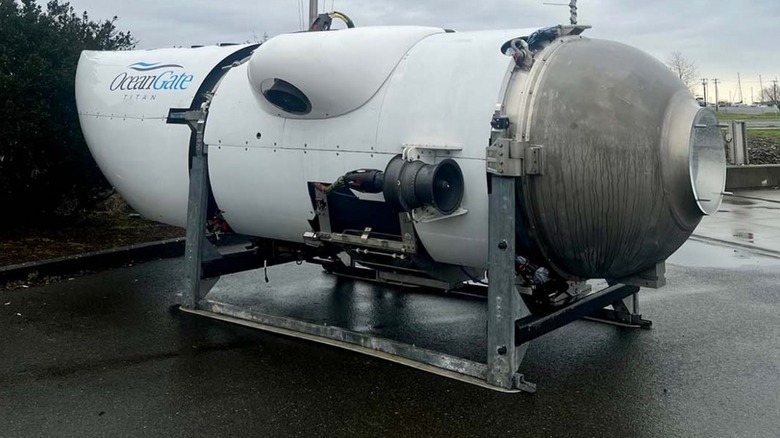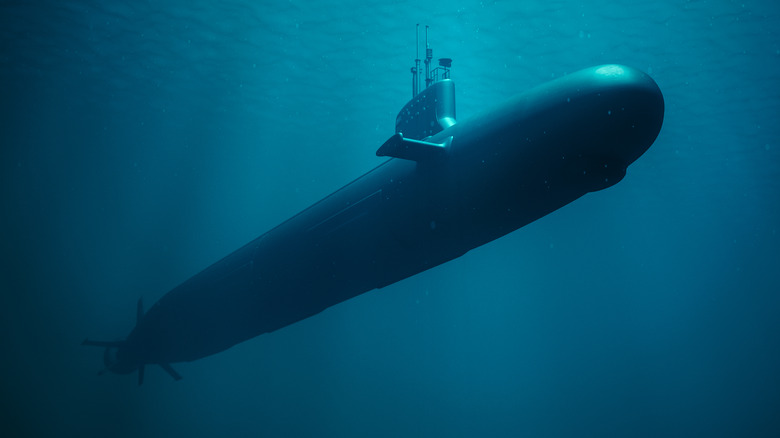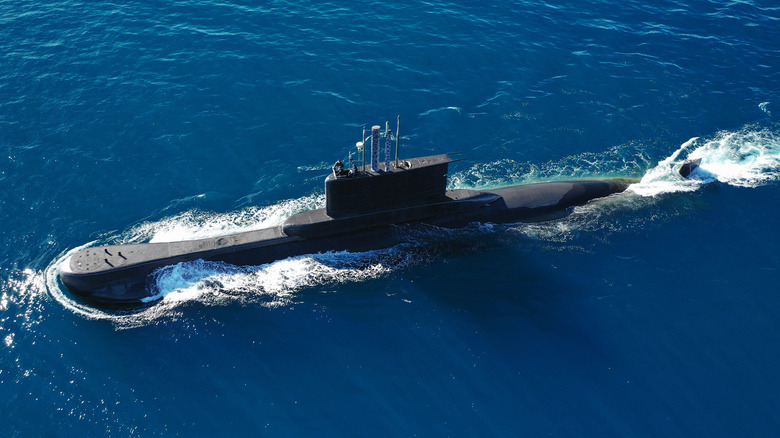The Reason Submarines Implode, According To Science
In June 2023, the Titan submersible headed into the ocean to view the wreckage of the Titanic. According to a statement from the U.S. Coast Guard (per CNN), all five people aboard the watercraft died in a catastrophic implosion. The statement came after fragments of the small, underwater vessel were identified in a debris field discovered in the search area after the Titan lost contact with the surface. The Titanic wreck rests at an estimated 13,000 feet below the surface of the North Atlantic — a depth of immense water pressure.
Implosions of any kind occur when the air or water pressure outside an object is so much that it can no longer withstand the strain and collapses in on itself. This is opposed to an explosion, when the pressure inside an object — like a balloon — causes the object to expand outward to such a point that it blows up. According to Dr. Nicolai Roterman from the University of Portsmouth, at a depth of more than 2 miles — where the Titanic wreckage rests — there was over 5,500 pounds per square inch (PSI) on the Titan. Comparatively, it experienced less than three-tenths of a percent of that pressure at sea level (via Forbes).
The 2023 Titan disaster was not the first time in maritime history that a submarine — or in this case, a submersible — imploded due to the intense water pressure bearing down on it. In 1963, the U.S.S. Thresher sank and eventually imploded some 450 feet below its test depth, according to the U.S. Naval Institute. All aboard the Thresher were killed.
A crack or fault in the hull can cause an implosion
As mentioned, the Titan was a submersible — a small craft that must operate with the assistance of a mother ship, as opposed to a larger, fully autonomous submarine. Nevertheless, the principles of what might cause the implosion of each are much the same. CP24 reported that fragments of the Titan craft were found nearly 13,000 feet below the surface, and Coast Guard Rear Admiral John Mauger said (via The Guardian) what searchers discovered is "consistent with a catastrophic loss of the pressure chamber." According to the Daily Mail, water pressure at the Titanic wreckage is about 400 atmospheres — a far cry from the approximately 1 we're used to at sea level.
To get some sense of an implosion, imagine crushing an empty aluminum soda can in your fist — the pressure bearing down on the can is more than the structure of the can resist. For this reason, Dr. Nicolai Roterman said of Titan, "If there was any kind of hull breach, the occupants would succumb to the ocean in a near instant." For some idea of what deep-sea pressure might be like at such depths, Professor Blair Thornton from the University of Southampton compared it to the weight of the Eiffel Tower (via NBC News).
In 2020, a Chinese manned submersible called "Fendouzhe" — or "Striver" — reached depths of 33,000 feet (the bottom of the Mariana Trench, known as Challenger Deep, in the Pacific Ocean.) In 2012, Titanic director James Cameron also reached Challenger Deep in a submersible, CBS News reports.
Sub design helps prevent implosions
In advance of James Cameron's dive, the Hollywood director said (per The New York Times), "You'd be an idiot not to be apprehensive, but I trust the design." According to the MarineBio Conservation Society, the cylindrical design of subs and submersibles helps address water pressure issues. Submarines in particular are built with two hulls: The inner — or pressure hull — helps protect the sub from getting crushed and from the freezing temperatures, and the outer hull helps maintain the watercraft's shape.
OceanGate co-founder Guillermo Söhnlein, who left OceanGate years before the Titan tragedy, said (via Forbes) that any "failure" in a submarine or submersible can cause "an instantaneous implosion." Despite repeated concerns from those involved in the project, the Titan made a number of successful deep-sea dives before the accident — it traveled to the site of the Titanic two times without incident, Diario AS reports. However, Jasper Graham-Jones — associate professor of mechanical and marine engineering at the University of Plymouth — told Associated Press that returning to such depths may have caused what's called "delamination" in the hull, or a gradual splitting of the carbon fiber.
According to The Conversation, the Titan was designed to withstand pressure of up to 4,000 meters — around 13,000 feet — and was equipped with a real-time hull monitoring system to detect any possible damage or strain. In the Coast Guard press conference announcing the Titan had imploded and all aboard were dead, Coast Rear Admiral John Mauger said it was unclear when — if ever — human remains might be recovered.


